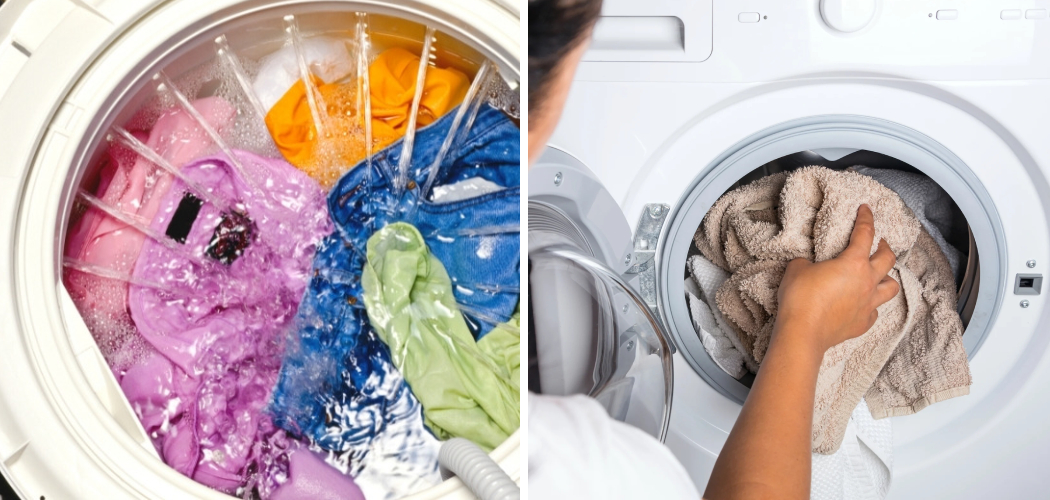Are you tired of dealing with clothes that are dingy or covered in detergent residue after washing them? If so, consider adding a rinse cycle to your regular laundry routine. Taking the time to incorporate this important step into your laundry process will help ensure that all your garments come out looking and feeling softer and more refreshingly clean than ever!

Rinse cycles can be easily added to your washing machine settings, providing many benefits, from removing soap suds to minimizing wrinkles. Plus, it’s simple and quick – you only have to push a button or turn a dial!
Read on for an easy-to-follow guide detailing how to use rinse in washing machine.
What Will You Need?
Once you’ve got your laundry in the washer, all you need to do is add a rinse cycle. Nearly every washing machine has this setting available; however, it may occasionally be hidden or have a different name. Here are some things to consider before starting the rinse cycle:
- Make sure that the detergent is properly washed out of your clothes.
- Consider using a fabric softener with the rinse cycle to add freshness and softness.
- If you have hard water, adding a second rinse can help remove mineral deposits that might be left on your clothes.
Now that you know why rinsing is beneficial and what to consider before starting the cycle – it’s time for the easy-peasy instructions.
10 Easy Steps on How to Use Rinse in Washing Machine
Step 1. Load Your Laundry into the Washer:
Start by sorting your clothes into similar colors and materials, then load them into the drum of your washing machine. Do not overload the washer; clothes need plenty of space to move around during the washing and rinsing. If your laundry load is too large, consider breaking it into smaller loads to ensure proper cleaning and rinsing.
Step 2. Choose Your Detergent:
Select a high-quality detergent that suits your clothing materials and colors. Pour the recommended amount of detergent into the dispenser drawer, ensuring that it does not exceed the marked line. More detergent doesn’t necessarily mean cleaner clothes, and in fact, it can leave a residue that the extra rinse cycle will need to remove.

Step 3. Select the Appropriate Wash Cycle:
Choose the wash cycle that best suits the type of clothes you are washing. Most washing machines offer a variety of settings, such as ‘delicate’ for fragile items, ‘heavy duty’ for sturdy materials, and ‘quick wash’ for lightly soiled items. After selecting your preferred wash cycle, don’t forget to also select the temperature settings.
Step 4. Activate the Rinse Cycle:
Now, find the option on your washing machine to add an extra rinse cycle. This could be a button, a dial, or a setting within the machine’s digital menu. The terminology may vary depending on your machine model, but look for words like “extra rinse,” “second rinse,” or “additional rinse.” Once you’ve located the correct setting, activate it to include an additional rinse in your wash cycle.
Remember, adding an extra rinse cycle will extend the overall washing time. Still, it is instrumental in removing excess detergent and residue from your clothes, resulting in softer and cleaner garments.
Step 5. Start the Washing Machine:
After setting up your wash cycle and activating the extra rinse option, it’s time to start the washing machine. Press the start button and let the machine do the rest. Be patient; your clothes will soon be excellently clean and fresh!
Step 6. Monitor the Washing Machine:
While your clothes are washing, take a moment to check on the machine periodically. Some washers have an automatic rinse cycle, while others require you to start it once the initial wash cycle is complete manually. If this is the case for your machine, start the rinse cycle when prompted.
Step 7. Remove the Clothes:
Once the rinse cycle is complete, promptly remove your clothes from the washing machine. Leaving clothes in the washer for long periods can lead to the growth of mildew and unpleasant odors. Before removing, check to ensure all detergent has been rinsed off. If you still notice any soap suds or residue, run another rinse cycle.
Step 8. Dry Your Clothes:
After removing your clothes from the washing machine, it’s time to dry them. You can air dry your clothes on a clothesline or use a dryer. If using a dryer, separate your clothes into similar materials to prevent damage, and select the appropriate drying cycle. Remember not to overload the dryer as well; clothes need ample space to tumble for effective drying.

Step 9. Fold or Hang Your Clothes:
Upon drying your clothes, promptly fold or hang them to prevent wrinkles and creases. Clothes left in a heap can become wrinkled, making them look untidy and possibly requiring ironing. Hanging or folding clothes immediately also helps keep your laundry area organized and makes it easier to locate specific items when you need them.
Step 10. Enjoy Your Clean, Fresh Clothes:
After completing the washing cycle with an extra rinse and properly drying your clothes, it’s time to enjoy the results. Your clothes should now look cleaner, feel softer, and smell fresher. An extra rinse cycle can make a noticeable difference in the quality of your laundry results, making the slightly longer wash time well worth it. Enjoy the comfort and freshness of your clothes, and take pleasure in knowing you’ve mastered how to use the rinse cycle in your washing machine effectively.
By following these ten simple steps, you can easily use the rinse cycle in your washing machine to ensure softer, cleaner, and fresher clothes every time. So don’t be hesitant to add an extra rinse when needed; it is a small step that can make a big difference in the overall cleanliness of your laundry.
5 Additional Tips and Tricks
- Use Appropriate Detergents: Always use washing machine-friendly detergents. Some detergents are specially formulated for machine wash, ensuring a proper rinse.
- Don’t Overload: Avoid filling the washing machine maximum capacity. It may hinder the rinse cycle and leave detergent residue on clothes.
- Water Temperature: The rinse cycle usually uses cold water, but check your machine’s manual to confirm its default settings and adjust if needed.
- Additional Rinse Cycle: If your clothes are filthy or have a lot of detergents left after a single rinse cycle, you may want to use the additional rinse cycle option.
- Clean Your Machine Regularly: A clean washing machine performs better and ensures a more efficient rinse. Regularly clean your machine’s drum and detergent drawer to prevent build-up.

With these tips, you can ensure that your rinse cycle works effectively and leave your clothes feeling clean. Remember to always follow the manufacturer’s instructions for best results.
5 Things You Should Avoid
- Avoiding Cold Rinse: While it may seem like hot water would be better for removing dirt, it’s important to remember that the rinse cycle often uses cold water to remove detergent properly. Avoid overriding this setting unless specifically advised in the manual.
- Ignoring Rinse Aid: Rinse aids enhance the washing machine’s rinse cycle, especially in hard water. Avoid ignoring these aids if you want your clothes to be thoroughly rinsed.
- Excess Detergent: More detergent does not mean cleaner clothes. Too much can lead to residue build-up that the rinse cycle can struggle to remove. Avoid using more than the recommended amount.
- Skipping Regular Maintenance: Regular maintenance can impact how well your washing machine rinses your clothes. Pay attention to this important routine to ensure your machine runs efficiently.
- Ignoring the Machine’s Manual: The manufacturer’s manual provides specific instructions for the optimal use of your washing machine, including the rinse cycle. Avoid making assumptions about your machine’s operations without referring to the manual first.
Avoiding these common mistakes will help you get the most out of your washing machine’s rinse cycle and leave your clothes feeling fresh and clean.
What Comes After Rinse Cycle?
After the rinse cycle, most washing machines will enter a spin cycle to remove excess water from your clothes. This prepares them for drying, whether you air or use a dryer. Follow the manufacturer’s instructions for the best results in rinsing and drying your clothes. Always remember to clean and maintain your machine for optimal performance. regularly
Spin cycle speeds may vary, but most washing machines have a default setting that works well for most types of clothing. Depending on your needs, you may also have the option to choose a slower or faster spin speed. When in doubt, refer to the machine’s manual for guidance.
Overall, understanding how to properly use and maintain the rinse cycle in your washing machine is essential for achieving clean and fresh clothes. By following these tips and avoiding common mistakes, you can ensure that your clothes come out of the wash feeling and smelling great every time.
Which Mode is Best for Washing Machine?
The best mode for your washing machine will depend on your specific needs and the type of load you are washing. Some machines have different wash modes, such as delicate, heavy-duty, or quick wash. It’s important to choose the appropriate mode based on the type of fabric and level of dirt in your clothes. Always refer to the manufacturer’s instructions for guidance on which mode is best for your washing machine. Regularly cleaning and maintaining your machine will also help ensure all modes work effectively.

In addition, some machines also have different rinse cycle options, such as extra rinse or prewash. These can be useful for heavily soiled clothes or those with sensitive skin who may need an extra rinse to remove any remaining detergent residue. Again, refer to the manual for the best usage of these options.
With proper use and maintenance, your washing machine will continue to serve you well for years. So, feel free to experiment with different modes and cycles to find what works best for you and your laundry needs.
Conclusion
This was just an introduction to the world of rinse in a washing machine, but there is still much more to explore. If you want to try out a rinse cycle in your wash machine, it’s a simple process that can save time and energy. From clothing that will last longer to improved stain removal, several benefits come with adding this extra step.
When you feel comfortable executing this simple technique, don’t forget to experiment with different fabrics and different cleaning solutions for even better results. Finally, use your experience and understanding of how the wash cycle works to make your laundry stay cleaner and brighter than ever before.
Hopefully, the article on how to use rinse in washing machine has helped you understand the importance of this step in your laundry process. Use these tips and techniques to get cleaner, fresher clothes with the help of your trusty washing machine. So go ahead, give it a try, and see the difference for yourself! Happy washing!

